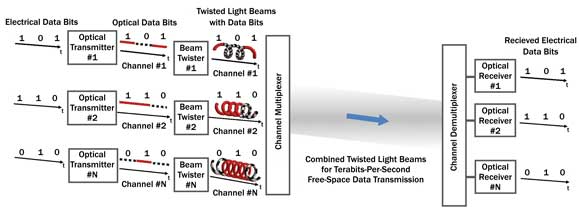
Terabits transmitted by twisted light
Do you ever wish you could download that Netflix movie you’ve been dying to see in a matter of just a few seconds rather than those 15 long, grueling minutes, or watch the latest viral YouTube video without the hassle of buffering? Well, your wish may soon come true, thanks to a new method that combines twisted beams of light to transmit data at up to 2.56 terabits per second.
An international team led by University of Southern California researchers has developed a twisted-light system that transmits more than 85,000 times more data per second than broadband cable, which supports up to about 30 megabits per second. The technique could lead to fabrication of high-speed satellite communication links or be adapted for use in fiber optics.
“Today’s deployed fiber does not readily accommodate twisted light beams and orbital angular momentums (OAMs),” USC electrical engineering professor Alan Willner told Photonics Spectra. “Work is being done to develop fibers that could accommodate OAMs, for example ringlike fiber instead of central core fibers.”
 Multiple data channels, each on a different light beam having a “front” that twists in a different helical shape as it propagates, can be combined (i.e., multiplexed) to produce an aggregate of terabits per second of free-space data transmission capacity.
Multiple data channels, each on a different light beam having a “front” that twists in a different helical shape as it propagates, can be combined (i.e., multiplexed) to produce an aggregate of terabits per second of free-space data transmission capacity.
The team used beam-twisting “phase holograms” to manipulate eight beams of light so that each twisted in a DNA-like helical shape as it propagated in free space. There are in theory no limitations on the number of beams that can be manipulated, Willner said; one key limitation would be the need for an infinitely large aperture.
Each beam can be encoded with “1” and “0” data bits, making each an independent data stream – similar to separate channels on a radio.
To simulate the type of communications that occur between satellites in space, the team demonstrated free-space data transmission in a lab.
Next, the researchers plan to increase the number of twists they can combine and the data rate they can send, and to manipulate twisted beams in a network function. For example, the scientists would like to be able to switch data from one twist to another and vice versa.
“The twisting of light, it doesn’t increase the capacity of one beam, but enables it to multiplex many beams,” he said. “The magic is that these twists are orthogonal. They can be combined and separated.”
The study, funded by DARPA under the InPho (Information in a Photon) program, appeared in Nature Photonics (doi: 10.1038/NPHOTON.2012.138).
Published: September 2012